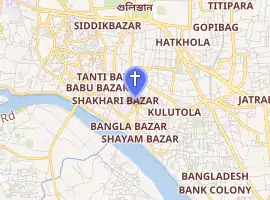St Thomas Church, Dhaka
St Thomas Church is an Anglican Church which is also known as the Church of Bangladesh . The church premise was in an area of lush greeneries with the famous Bahadur Shah Park at a stone's throw distance on the south. The north-south axial Nawabpur Road/Johnson Road, the most important commercial street connecting the old part of the city with the new, is on the west and separated the area from the court, Bank, DC's office and Jagannath University buildings across it. In fact the church overlooking the greens is a major focal of the city centre in the nineteenth century.
| St Thomas Church, Dhaka | |
|---|---|
.jpg.webp) St Thomas's in 1904 by Fritz Kapp | |

| |
| Location | Johnson Road, Dhaka |
| Country | Bangladesh |
| Denomination | Church of Bangladesh |
| History | |
| Status | Cathedral |
| Architecture | |
| Functional status | Active |
| Architectural type | Gothic architecture |
| Groundbreaking | 1819 |
| Completed | 1821 |
| Clergy | |
| Bishop(s) | The Most Revd Paul S. Sarkar |
History
Construction of the church, located on the east side of Johnson Road, began in 1819 and was completed in 1821. It was inaugurated on 10 July 1824 by Bishop Reginald Heber of Calcutta (Kolkata) while he was visiting Dacca (Dhaka).[1][2] It has served as cathedral church since 1951.[2] It is said that the convicts from Dhaka Jail gave their labour to build this church as well.
The Anglicans, Presbyterians, Congretationalists of East Bengal, and various Methodist and Baptist bodies joined together to form the Church of Pakistan in the early 1970s. After Bangladesh won its independence from Pakistan in 1971, the Diocese of Dhaka emerged from the Church of Pakistan as the independent Church of Bangladesh.[3]
The church is led by most reverend Paul S. Sarkar who in January 2003 became the third bishop of the Church of Bangladesh. The 71 parishes are divided into 2 dioceses. The church has approximately 15,600 members (2005). It has been a member of the World Council of Churches since 1975 and functions as part of the larger worldwide Anglican Communion.
Architectural features
The attraction of this building, built after the style of east churches, with a square clock tower with arch windows on its walls. The square clock tower rises in two stages,[4] its top is embattled. The roof used wooden battens on iron joists. The roofs of the verandas on either side are set upon sloppy korhikath.[1] The delicate stone and brick works of this white plastered building are still as immaculate as it has been for nearly two centuries. A small porch leads to the entrance of the church supported on four columns which are of perpendicular gothic design on top of the entrance.
The west end of the nave is dominated by two grooved columns that are not weight bearing.[1] The floor have tiles. There are two columns at the back of the rectangular nave which leads to a pulpit through an arch. The pulpit is rectangular and has a brass cross on the wall at the back. The altar, at the east end of the nave,[1] is constructed of wood and also has a brass cross on top of it. There are elegant curved chairs for congregation. A stone font on the back of the nave. The walls of the church are adorned with stone tablets commemorating some of the members of the church. Even most of the thick teak furniture, altar, and ablution bowl (for baptising) in marble are still unblemished and in good working condition. However, the open colonnades around two sides of the nave (central axial hall) were walled up later.
In 2005 the church authority has undertaken a massive renovation of the building. Archaeologist Sufi Mostafizur Rahman writes that, "Though the church is small in size, it is one of the most attractive ones in Bangladesh".[1]
References
- Rahman, Sufi Mostafizur; Khandakar, Kamrun Nesa; Showrov, Shohrab Uddin (2007). "Architecture". In Rahman, Sufi Mostafizur (ed.). Archaeological Heritage. Cultural Survey of Bangladesh Series. Volume 1. Asiatic Society of Bangladesh. p. 348. OCLC 298612813.
- This church was built ... (Plaque inside church). Dhaka: St Thomas Church.
- Melton, J. Gordon; Baumann, Martin, eds. (2010). "Bangladesh". Religions of the world: A comprehensive encyclopedia of beliefs and practices. Volume 1: A-B (2nd ed.). ABC-CLIO. p. 280. ISBN 978-1-59884-203-6.
- Haque, Enamul (2009). Dhaka alias Jahangirnagar: 400 years. Dhaka: International Centre for Study of Bengal Art. p. 368. ISBN 978-984-33-0343-1.
The square steeple rises in two stages, a clock is placed on the upper level.